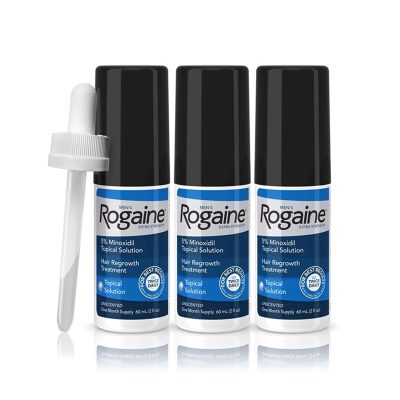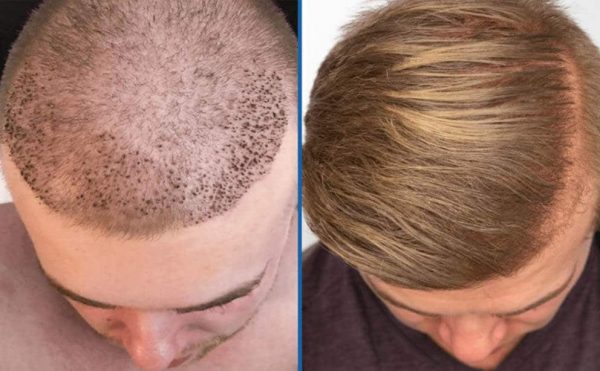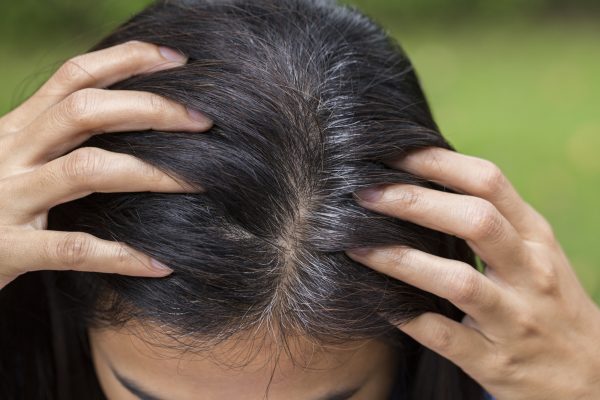Male-pattern hair loss, the most prevalent cause of hair loss in males, can start at a young age. It might begin as early as your late teens or early twenties. It usually occurs later.
More than half of white males over the age of 50 exhibit obvious signs of male-pattern hair loss, such as significant thinning, a receding hairline, or balding.
While you may not need to treat this sort of hair loss, there are therapeutic alternatives available. Medication can help to prevent additional hair loss, and some men even regrow part of their hair. Men who get the best outcomes begin therapy as soon as they notice hair loss.
Here’s what you can do to cure androgenetic alopecia (the medical name for this type of hair loss).
Medication Authorized By The FDA For Male-Pattern Hair Loss
The following drugs have been authorized by the Food and Drug Administration (FDA) to treat male-pattern hair loss. Here’s the skinny on each.
Minoxidil Topical (Available Without Prescription)

Get it now on Amazon.com
This is the most widely used therapy for male-pattern hair loss, and it is widely accessible in shops and online.
What studies show: Minoxidil has been demonstrated in clinical trials to minimize hair loss, stimulate hair growth, and strengthen existing hair strands. While minoxidil can aid, complete regrowth is unlikely.
How to use it?
Massage into your scalp.
When to use it?
Minoxidil should be administered twice daily.
How long does it take to see results?
Some men respond better to minoxidil than others, while some men do not. It may take up to six months to notice effects if minoxidil works for you. It is critical to follow the guidelines and apply minoxidil twice a day, every day.
Possible adverse effects include an itchy scalp in some men who use minoxidil. The improved foam composition appears to lessen this danger. Other potential adverse effects include itching skin and headaches.
Can be used alone: Many men experience success while using simply minoxidil. If you visit a dermatologist, your treatment plan may include the use of prescription medicine. This may enhance outcomes.
If you stop using minoxidil, the newly grown hair will fall off. This normally takes three to four months. According to dermatologists, some men’s hair loss appears to be worse than before they started using minoxidil. What’s occurring is that you’re experiencing hair loss that would have occurred if you hadn’t treated it.
Finasteride (Prescription Medication)
This is a prescription drug that you would take for an extended period of time. Finasteride has been demonstrated in tests to delay additional hair loss in around 80% to 90% of men who use it. Some men see hair regeneration, which is more common in men who begin finasteride when they first discover indications of hair loss. Take a pill and follow the directions on the package.
When to use it?
Every day.
How long does it take to see results?
If finasteride works for you, you should notice results in around 6 months.
Any adverse effects?
Some men who use finasteride have had side effects. These symptoms include loss of libido (desire for sex), inability to obtain or maintain an erection, breast enlargement and tenderness, and sadness.
Sexual adverse effects have been documented to persist after a patient stops using finasteride. Because these side effects are so significant, your dermatologist will want to learn more about you before prescribing finasteride.
Your dermatologist will do a thorough examination and inquire about any pre-existing diseases or drugs you are currently taking.
If finasteride is part of your treatment strategy, you can take it alone or in conjunction with minoxidil.
If you stop using finasteride, you must keep taking one tablet every day to preserve your results. Hair loss resumes once you stop using this medicine.
Concerning Laser Hair Loss Devices For Men
Several laser technologies are now available for home hair loss treatment. Some have been approved by the FDA. If you see the phrase “FDA cleared” on the package or in laser literature, it signifies the FDA has approved the laser as a safe therapy.
The standards for FDA clearance are substantially less strict than those for FDA approval.
Procedures for treating male-pattern hair loss
Your dermatologist may prescribe one (or both) of the following treatments, depending on the location and intensity of your hair loss:
- Hair transplant:
If you want a permanent remedy, you might think about getting a hair transplant. This treatment no longer entails shifting hair plugs from one area of your scalp to another. A hair transplant can now provide lifelong, natural-looking results.
- Platelet-rich plasma (PRP):
While PRP is not a long-term solution, maintenance treatments can help you keep the benefits you’ve achieved. PRP can be used alone or in conjunction with a hair transplant to boost outcomes.
Here’s what you may anticipate if your dermatologist suggests PRP for you. A little sample of your blood is extracted and deposited in a machine that separates your red blood cells from your plasma.
After that, your plasma is pumped into your scalp. This takes around 10 minutes.
You will need to return for more injections, return once a month for the first three months, and return every three to six months.
PRP may help reduce hair loss in a matter of months. Some people see hair strengthening or regrowth soon after.
How a dermatologist may assist you with hair loss?
Making an appointment to see a dermatologist is a good place to start if you want to do something about hair loss. A dermatologist can determine the type of hair loss you are experiencing. This is significant since different forms of hair loss necessitate distinct therapies.
A dermatologist can also advise you on the expected outcomes of therapy. If you wish to address your hair loss, a dermatologist can advise you on the best treatment choices for you.


